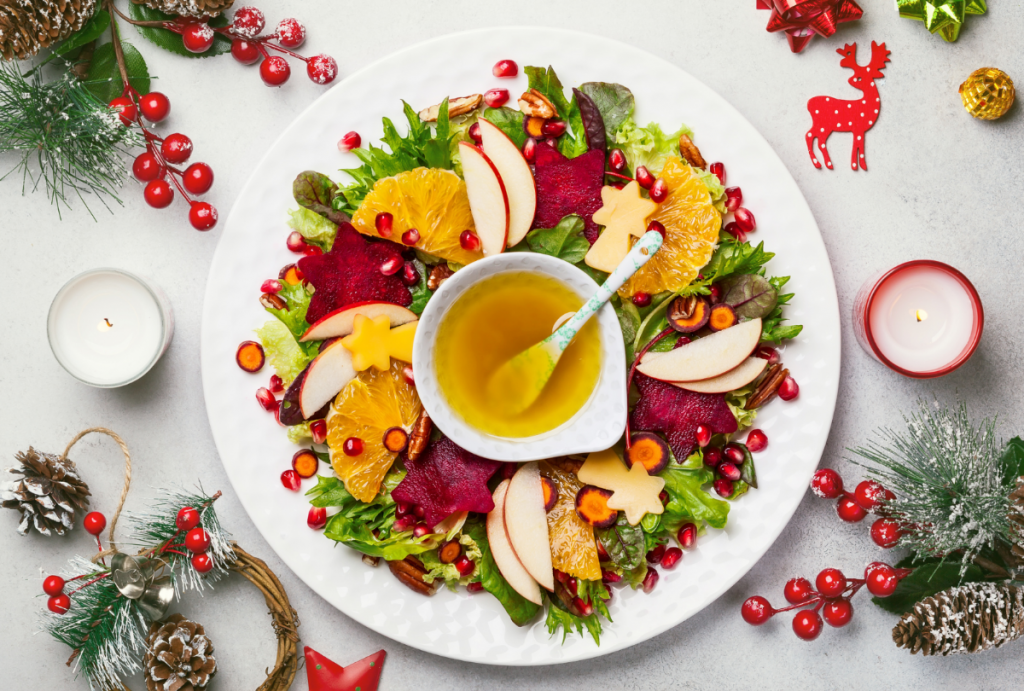
To help you navigate the festive season, we’ve compiled a list of five Aussie Christmas foods to nourish your microbiome without compromising your gut health.
The festive period is upon us! Whether you celebrate Christmas, Hanukkah or Kwanzaa, most festivities generally centre around food. While indulging on occasion won’t impact your overall health, the cumulative effect of weeks of parties and socialising over the festive season can wreak havoc on both your waistline and gut health for the rest of the year.
Fruit salad
The festive season heralds the start of summer in Australia meaning we have a huge range of seasonal fruits to choose from including mangoes, watermelon and stone fruit. The largest ever study done which explored the link between diet and the microbiome identified that fruit, tea and coffee all had important impacts on the microbiome1. This study used whole genome sequencing which is the most advanced technology available to measure the microbiome. These foods are all high in plant chemicals known as phytochemicals. Some phytochemicals help us by killing off pathogenic bacteria while others feed the beneficial microorganisms in our guts. Different coloured fruits are rich in different phytochemicals so serving a multicoloured fruit salad won’t only look fabulous but also ensure we are consuming lots of these different plant chemicals.
Spices
Nothing says Christmas more than the smell of warm spices wafting from the kitchen. You might associate spices with treat foods such as gingerbread or mulled wine, but you can also add spices to more microbiome friendly foods. For example, cinnamon is delicious added to your roast carrots or pumpkin.
The reason spices are so aromatic and flavoursome is that they are some of the richest sources of beneficial plant chemicals2.
This makes them some of the most potent antioxidant foods you can consume2. As such, even small quantities of spices can play an important role in microbiome health.
Nuts
There is mounting evidence that nuts are great for overall and microbiome health. Nuts are whole plant foods which are jam-packed with nutrition, including prebiotic fibre which will feed your microbiome. Nuts are also rich sources of iron and protein, making them a great vegetarian alternative to meat. Additionally, the monounsaturated and polyunsaturated fats found in nuts are considered ‘healthy’, in comparison to animal fat, as they do not increase cholesterol levels. However, even these ‘healthy’ fats are still full of kilojoules, which means they will still lead to weight gain if you eat them in excess. As a guide, a meta-analysis of 18 different research studies found that three serves of nuts per week are sufficient to receive the maximum health benefits3. A standard serve of nuts is 28 grams which is equivalent to about 8 brazil nuts, 14 macadamias, or 20 almonds.

Potato salad
When we cook and cool starchy foods such as potatoes, rice or pasta some of the starch is converted into resistant starch. Resistant starch is very similar to starch except the structure is too complex to allow complete digestion in the small intestine. This is important for your gut microbiome as it means that resistant starch reaches the large intestine where it acts as a prebiotic fibre to feed beneficial gut microbes4. So not only are potato, rice or pasta salads a fabulous way to use leftovers, they are also a great way to increase our fibre intake which is essential to attaining our optimal microbiome function.
Don’t forget the ham!
Ham is a firm classic of the traditional Aussie Christmas feast but unfortunately, science does not support it as a beneficial food for the microbiome. However, we can still enjoy some ham without compromising our microbiome health by consuming it in moderation and balancing it out with rich sources of fibre and phytochemicals such as vegetables and salads. Even apple and cranberry sauce will add some prebiotic fibre and phytochemicals, however, these are also high in sugar so again moderation is the key.

Interested in discovering the bacterial species in your gut and what they might be doing? Learn more with Insight.
This microbiome test is not intended to be used to diagnose or treat medical conditions. A full disclaimer is available here
References
1). Zhernakova, A., Kurilshikov, A., Bonder, M. J., Tigchelaar, E. F., Schirmer, M., Vatanen, T., … & Wang, J.
Population-based metagenomics analysis reveals markers for gut microbiome composition and diversity.
Science, 352(6285), 565-569 (2016). Doi: 10.1126/science.aad3369
2). Yashin, A., Yashin, Y., Xia, X., & Nemzer, B.
Antioxidant activity of spices and their impact on human health: A Review.
Antioxidants, 6(3), 70 (2017). Doi: 10.3390/antiox6030070
3). Chen, G. C., Zhang, R., Martínez-González, M. A., Zhang, Z. L., Bonaccio, M., Van Dam, R. M., & Qin, L. Q.
Nut consumption in relation to all-cause and cause-specific mortality: a meta-analysis 18 prospective studies.
Food &function, 8(11), 3893-3905 (2017). Doi: 10.1039/c7fo00915a
4). Yang, X., Darko, K. O., Huang, Y., He, C., Yang, H., He, S., … & Yin, Y.
Resistant starch regulates gut microbiota: structure, biochemistry and cell signalling.
Cellular Physiology and Biochemistry, 42(1), 306-318 (2017). Doi: 10.1159/000477386



